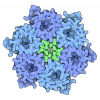[English] 日本語
 Yorodumi
Yorodumi- PDB-8c5v: Chemotaxis core signalling unit from E protein lysed E. coli cells -
+ Open data
Open data
- Basic information
Basic information
| Entry | Database: PDB / ID: 8c5v | |||||||||||||||||||||
|---|---|---|---|---|---|---|---|---|---|---|---|---|---|---|---|---|---|---|---|---|---|---|
| Title | Chemotaxis core signalling unit from E protein lysed E. coli cells | |||||||||||||||||||||
 Components Components |
| |||||||||||||||||||||
 Keywords Keywords | MEMBRANE PROTEIN / Chemotaxis / Signal Transduction | |||||||||||||||||||||
| Function / homology |  Function and homology information Function and homology informationregulation of protein histidine kinase activity / negative regulation of protein modification process / detection of chemical stimulus / methyl accepting chemotaxis protein complex / positive regulation of post-translational protein modification / bacterial-type flagellum-dependent swimming motility / regulation of bacterial-type flagellum-dependent cell motility / aerotaxis / protein histidine kinase activity / cell tip ...regulation of protein histidine kinase activity / negative regulation of protein modification process / detection of chemical stimulus / methyl accepting chemotaxis protein complex / positive regulation of post-translational protein modification / bacterial-type flagellum-dependent swimming motility / regulation of bacterial-type flagellum-dependent cell motility / aerotaxis / protein histidine kinase activity / cell tip / regulation of chemotaxis / thermotaxis / signal complex assembly / histidine kinase / receptor clustering / phosphorelay signal transduction system / phosphorelay sensor kinase activity / establishment of localization in cell / cell motility / cellular response to amino acid stimulus / transmembrane signaling receptor activity / chemotaxis / protein domain specific binding / phosphorylation / signal transduction / ATP binding / identical protein binding / plasma membrane / cytoplasm / cytosol Similarity search - Function | |||||||||||||||||||||
| Biological species |  | |||||||||||||||||||||
| Method | ELECTRON MICROSCOPY / subtomogram averaging / cryo EM / Resolution: 12 Å | |||||||||||||||||||||
 Authors Authors | Cassidy, C.K. / Qin, Z. / Zhang, P. | |||||||||||||||||||||
| Funding support |  United Kingdom, United Kingdom,  United States, European Union, 6items United States, European Union, 6items
| |||||||||||||||||||||
 Citation Citation |  Journal: mBio / Year: 2023 Journal: mBio / Year: 2023Title: Structure of the native chemotaxis core signaling unit from phage E-protein lysed cells. Authors: C Keith Cassidy / Zhuan Qin / Thomas Frosio / Khoosheh Gosink / Zhengyi Yang / Mark S P Sansom / Phillip J Stansfeld / John S Parkinson / Peijun Zhang /   Abstract: Bacterial chemotaxis is a ubiquitous behavior that enables cell movement toward or away from specific chemicals. It serves as an important model for understanding cell sensory signal transduction and ...Bacterial chemotaxis is a ubiquitous behavior that enables cell movement toward or away from specific chemicals. It serves as an important model for understanding cell sensory signal transduction and motility. Characterization of the molecular mechanisms underlying chemotaxis is of fundamental interest and requires a high-resolution structural picture of the sensing machinery, the chemosensory array. In this study, we combine cryo-electron tomography and molecular simulation to present the complete structure of the core signaling unit, the basic building block of chemosensory arrays, from . Our results provide new insight into previously poorly-resolved regions of the complex and offer a structural basis for designing new experiments to test mechanistic hypotheses. | |||||||||||||||||||||
| History |
|
- Structure visualization
Structure visualization
| Structure viewer | Molecule:  Molmil Molmil Jmol/JSmol Jmol/JSmol |
|---|
- Downloads & links
Downloads & links
- Download
Download
| PDBx/mmCIF format |  8c5v.cif.gz 8c5v.cif.gz | 1.2 MB | Display |  PDBx/mmCIF format PDBx/mmCIF format |
|---|---|---|---|---|
| PDB format |  pdb8c5v.ent.gz pdb8c5v.ent.gz | 992.8 KB | Display |  PDB format PDB format |
| PDBx/mmJSON format |  8c5v.json.gz 8c5v.json.gz | Tree view |  PDBx/mmJSON format PDBx/mmJSON format | |
| Others |  Other downloads Other downloads |
-Validation report
| Summary document |  8c5v_validation.pdf.gz 8c5v_validation.pdf.gz | 1.4 MB | Display |  wwPDB validaton report wwPDB validaton report |
|---|---|---|---|---|
| Full document |  8c5v_full_validation.pdf.gz 8c5v_full_validation.pdf.gz | 1.5 MB | Display | |
| Data in XML |  8c5v_validation.xml.gz 8c5v_validation.xml.gz | 171 KB | Display | |
| Data in CIF |  8c5v_validation.cif.gz 8c5v_validation.cif.gz | 266.8 KB | Display | |
| Arichive directory |  https://data.pdbj.org/pub/pdb/validation_reports/c5/8c5v https://data.pdbj.org/pub/pdb/validation_reports/c5/8c5v ftp://data.pdbj.org/pub/pdb/validation_reports/c5/8c5v ftp://data.pdbj.org/pub/pdb/validation_reports/c5/8c5v | HTTPS FTP |
-Related structure data
| Related structure data |  15641MC M: map data used to model this data C: citing same article ( |
|---|---|
| Similar structure data | Similarity search - Function & homology  F&H Search F&H Search |
- Links
Links
- Assembly
Assembly
| Deposited unit | 
|
|---|---|
| 1 |
|
- Components
Components
| #1: Protein | Mass: 42462.648 Da / Num. of mol.: 2 / Source method: isolated from a natural source / Source: (natural)  #2: Protein | Mass: 14874.573 Da / Num. of mol.: 2 / Source method: isolated from a natural source / Source: (natural)  #3: Protein | Mass: 15675.938 Da / Num. of mol.: 4 / Source method: isolated from a natural source / Source: (natural)  #4: Protein | Mass: 55562.367 Da / Num. of mol.: 12 / Source method: isolated from a natural source / Source: (natural)  Has ligand of interest | N | |
|---|
-Experimental details
-Experiment
| Experiment | Method: ELECTRON MICROSCOPY |
|---|---|
| EM experiment | Aggregation state: CELL / 3D reconstruction method: subtomogram averaging |
- Sample preparation
Sample preparation
| Component | Name: Chemotaxis Core Signalling Unit from E-gene lysed E. coli cells. Type: COMPLEX / Entity ID: all / Source: NATURAL |
|---|---|
| Molecular weight | Experimental value: NO |
| Source (natural) | Organism:  |
| Buffer solution | pH: 7 |
| Specimen | Embedding applied: NO / Shadowing applied: NO / Staining applied: NO / Vitrification applied: YES |
| Vitrification | Cryogen name: ETHANE |
- Electron microscopy imaging
Electron microscopy imaging
| Experimental equipment |  Model: Titan Krios / Image courtesy: FEI Company |
|---|---|
| Microscopy | Model: FEI TITAN KRIOS |
| Electron gun | Electron source:  FIELD EMISSION GUN / Accelerating voltage: 300 kV / Illumination mode: OTHER FIELD EMISSION GUN / Accelerating voltage: 300 kV / Illumination mode: OTHER |
| Electron lens | Mode: BRIGHT FIELD / Nominal defocus max: 5000 nm / Nominal defocus min: 3000 nm |
| Image recording | Electron dose: 3 e/Å2 / Avg electron dose per subtomogram: 100 e/Å2 / Detector mode: COUNTING / Film or detector model: GATAN K2 QUANTUM (4k x 4k) |
- Processing
Processing
| EM software |
| ||||||||||||||||||||
|---|---|---|---|---|---|---|---|---|---|---|---|---|---|---|---|---|---|---|---|---|---|
| CTF correction | Details: emClarity / Type: PHASE FLIPPING AND AMPLITUDE CORRECTION | ||||||||||||||||||||
| Symmetry | Point symmetry: C2 (2 fold cyclic) | ||||||||||||||||||||
| 3D reconstruction | Resolution: 12 Å / Resolution method: FSC 0.143 CUT-OFF / Num. of particles: 5100 / Symmetry type: POINT | ||||||||||||||||||||
| EM volume selection | Num. of tomograms: 33 / Num. of volumes extracted: 20000 | ||||||||||||||||||||
| Atomic model building | Protocol: FLEXIBLE FIT / Space: REAL |
 Movie
Movie Controller
Controller




 PDBj
PDBj


